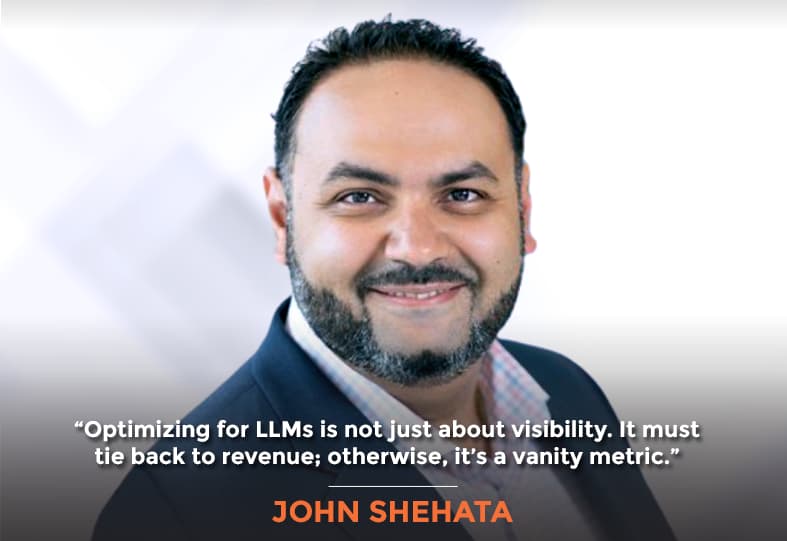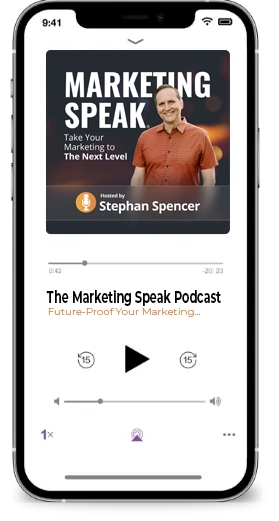The AI revolution isn’t just changing how we search—it’s fundamentally reshaping how content gets discovered, consumed, and monetized across the web. My guest on today’s show is John Shehata, founder of NewzDash and GDdash, and creator of the News & Editorial SEO Summit. Named one of USA Today’s top 10 SEO experts, John has optimized sites like ESPN, Reddit, and The Atlantic, and led global audience growth at Condé Nast across over 60 brands.
In our conversation, we unpack how Google’s AI overviews are reshaping traditional search behavior—and why Google Discover now accounts for 65% of publisher traffic. John breaks down the idea of query fan-out, where LLM answer engines like ChatGPT merge multiple user queries to generate rich, synthesized answers. We explore how strategies like content chunking and passage optimization have become critical for visibility in this new landscape.
John also shares practical ways to get your brand referenced in AI-generated results, along with survival tactics for publishers facing the collapse of display advertising. And in a bold move, he makes the case for adding “summarize with AI” buttons to articles, arguing that, paradoxically, it could increase reader engagement rather than dilute it.
This episode gives you the frameworks to thrive as AI reshapes how content gets discovered and consumed, so without any further ado, on with the show!

In This Episode
- [02:24] – John positions AI as a pivotal historical moment comparable to the shift from horse-drawn carts to automobiles, while examining how Google transforms into the new content middleman.
- [08:09] – The 11-step publisher survival blueprint emerges, with John advocating for strategic three-tier diversification across revenue streams, audience channels, and traffic sources to break free from failing display advertising models.
- [15:44] – Traffic decline myths get debunked as John demonstrates that many struggling publishers faced years of decline from poor content strategy and editorial philosophy—long before AI arrived on the scene.
- [17:26] – A traffic revelation unfolds: Google Discover now dominates publisher traffic at 65% of Google referrals, delivering click-through rates four times higher than traditional search results.
- [20:29] – The counterintuitive “Summarize with AI” button strategy gets unpacked, showing how publishers can boost engagement while positioning themselves as preferred sources in AI memory systems.
- [22:56] – Query fan-out mechanics come into focus as John demonstrates how AI systems transform single searches into multiple related queries, then synthesize comprehensive answers from diverse sources.
- [29:55] – Historical perspective emerges on technology’s writing influence, tracing from Civil War telegraph-era inverted pyramid structure through modern SEO and social media transformations.
- [34:50] – Societal readiness concerns surface as John questions whether education systems and individuals can adapt to Sam Altman’s prediction of 50% entry-level job elimination.
- [39:31] – Practical optimization tactics take center stage: measure AI visibility first, prioritize brand authority, conduct targeted testing, and tie all success metrics directly to revenue outcomes.
- [44:07] – John shares his contact information, directing listeners to connect via LinkedIn, where he accepts all requests, visit newzdash.com, or email [email protected], and mentions his News and Editorial SEO Summit.
John, it’s so great to have you on the show.
Hey, Stephan, it’s great to be here with you. Thank you so much for having me.
Yes, let’s first address the elephant in the virtual room: Is AI going to destroy the entire industry, all our jobs, and all the traffic?
I think that’s the question that keeps all of us awake at night. I definitely believe it’s a pivotal moment in time. This is when people moved from horse carts to actual cars. This kind of moment, right? And you cannot deny there is a huge change. Some people are in denial, “Oh, it’s the same thing. Just like, take whatever you did before and just apply it and add these couple of things to it.” It’s definitely a whole different thing. The world as we know it will definitely change.
I think people will continue to search by how big or small the search industry will be in the future. And this is different for various types of content, organizations, and sites, I think, particularly for transactional sites. It doesn’t matter. It’s a different platform. I can get my purchases or conversions through Google and social media. Now I can get them through like LLMs and AI modes and AI overviews.
Informational sites will lean on LLMs, search, and AI overviews—cutting out the traditional middleman.
So for them, the ultimate goal is like revenue, right? So not a big problem here. But when you talk about informational sites and new sites, this is actually the biggest impact, in my opinion, right? I believe informational sites will utilize LLMs, search, and AI overviews, along with AI mode, to replace the middleman in the equation. People don’t have to go to the best, I don’t know, sunglasses for men; they don’t have to go to GQ to check what the best ones are. And then from there, they click and buy one, and GQ will get a cut of it, right?
I think Google now has, and other LLMSs have enough information that they can make that, and they have all the shopping listings from all the sites. They have all the specs, and they can judge what is best for you. If they know your personality, they can utilize their memory and do hyper-personalization.
I think they can offer better results than any other site knows about you. And then, when it comes to news, this is the unknown. On one end, most of these LLMs and search engines will ground their searches because they have identified that this is a QDF (Query Deserves Freshness) and will try to obtain the information.
There are many laws now that prohibit you from simply taking content, summarizing it, and republishing it without permission, as news publishers would go out of business if there were no clicks back to their site, as it’s a display revenue model. Unfortunately, the majority of the news industry operates on a free model, while a few have adopted a subscription model. So, it really depends on how LLMS and search engines will take this, and how far they will go when it comes to news. Therefore, it affects different industries in various ways.
Yes, I think many of the informational and content sites are doomed. Most, I’d say, unfortunately. And you were talking about disintermediating the middleman, essentially, what you were describing was GQ, or whoever is offering some information about what the style is for the season, or whatever, and that’s no longer necessary. AI can figure that out and direct you to the Ray-Ban or whatever are the best suited for you.
Publishers must reinvent their revenue models. Smaller ones will inevitably be absorbed into larger organizations.
But here’s where it really rubs me raw, and that is Google is becoming the middleman, stepping into the role of middleman as an AI overview essentially just summarizing and stealing the content, putting it as an AI overview, and stealing the click, so there is no click to the content site that they stole and summarized and provided the answer. It’s kind of evil.
It is absolutely, and the other thing is also a catch-22. So, Google AI overviews, AI mode, and all the LLMs help you get the best content out there, understand it, right? Analyze it, synthesize it and give it. Provide it based on the user’s personalization preferences.
Now, what happens if these sites that provide that content stop providing it because they’re not getting clicks, making money,receiving commissions, or generating affiliate revenue, and so on? So, all that was left was garbage. Will these AI models say, “You know what? I’m not going to get that, I’m going to depend on whatever training data that I have based on all the content on the internet for the last 10, 20 years, and that’s it.” Or they will be grounding their searches into all the junk, right? Because if they don’t pay. This is what’s gonna be left on the internet.
So now you are feeding bad information. So garbage in, garbage out, kind of a thing, so it depends on how they’re gonna determine, right? “No, no, I have enough training model data. I don’t need any more information about the best sunglasses for men. I have all the shopping listings from every store online.
I have all their specs. I know what your face looks like, what color of your eyes. I know all these kinds of things. I don’t need any additional information from these content sites. I can actually base it on all the shopping listing information, details, and specs. I can offer you that I have all the latest science data or Blu Ray,” or whatever, you know, blue color, whatever orders a new scientific advantage for that specific thing, I can adjust based on the specs. So yes, but I feel it’s a catch-22, right?
Yeah. So, what are you telling your clients about their traffic heading south? Their impressions are up, but their clicks are down, and their ad impressions, therefore, result in ad revenue being down. What are you telling them to do? What’s your advice?

So the majority of our clients on the consulting side or the tool side are news publishers, right? We have both large and small publishers, such as USA Today, BBC, Reuters, NBC, and CBS. Or Netflix, FanDuel, which are very different in size, right? Well, we tell them that on the news side of things, we still don’t see that major impact.
We are measuring AI overviews for now, and we see about 3.4-3.5% visibility of AI overviews on news queries. So, what we excel at, if you think about it, is that there are many different types of queers. However, for simplicity, let’s categorize them as news and non-news, as is often done in practice. News, something’s happening now, people are interested, and they’re searching for it. Non-news is like, it could be old news, it could be evergreen, it could be transactional, whatever.
For news, trending queries, QDF specifically, the quick, right? We see a very low visibility of the AI overview. I think Google is treading very carefully. There was a story the other day, how this fictional story, Google took the summary and put it out there. And I was like, “so they’re very careful.” However, we notice that the AI overview comes later in time, especially for sports events, such as after seven to nine hours, and there is nothing that has changed. From this moment on, time has ended. Nothing in this moment will be developed beyond this moment.
And so I can say, “Do you know what? Here are the scores. This is the play, play, play. This is the analysis of the game done.” Okay, so we see that in sports, but so far, I say, “Okay, let’s calm down.” But when it comes to affiliate content, I think it’s a big question mark. I believe publishers have been utilizing affiliate revenue for some time now. It didn’t start with the AI overview. It started with helpful content updates, and a lot of that revenue has gone.
Convert as many people as possible into a direct audience—via email, push, SMS, or apps—to preserve the relationship.
I think they need to find opportunities where AI overviews are not available. I mean, we have to remember that LLM traffic is less than 1% compared to the rest of the traffic they’re receiving, but it’s definitely growing, along with adaptation and usage. I wrote an article outlining the 11 steps for publishers to survive in an AI-first era. And one of the things I discussed, or three of the things I discussed, is diversification of audience, diversification of revenue and diversification of channels.
If you discuss this, such as revenue, and you’re using a display revenue model, you’re in trouble. You have to diversify. Either if it’s events subscription, because not all the news content people will pay for, right? Maybe I pay for the New York Times, but I don’t pay for entertainment news; it’s all over the place. I don’t care. Perhaps I pay for niche-specific content. This is the MarketWatch, featuring market analysis, in-depth predictions, and more. I will pay for that, right? But maybe I don’t just pay for updated news and stuff.
Therefore, publishers must find alternative revenue models that support their business. I feel that a lot of smaller publishers will be consolidated into bigger organizations, and it will be like a loss-center kind of thing. So this is one diversification of traffic, I think they have to figure out what other channels are out there. And the biggest one, I used to work in candy and asked, which is a huge focus for me, how we can convert one gun user to a direct audience. So, you think about email subscriptions, push notifications, SMS, and all this stuff, as well as apps, that allow you to develop this daily habituation kind of behavior. Therefore, you need to convert as many people as possible so that you can maintain that relationship.
And then, finally, diversification of the audience. And I’m not sure a lot of people are looking into that. If your audience is in a certain age group, they’d say, “Hey, all my purchasing audiences are 45 and up. What are you doing for Gen Z and Gen Alpha, and maybe those who don’t search as much or are more focused on social media platforms, reels, and short video consumption?” So, you have to start thinking about this, because in five years from now, this will be the audience that has that person setting the power. So you need to address this right now.
So how do you address people who are getting their information from TikTok, doing searches on platforms like that for short-form content?
Younger generations now live inside their apps. Soon, our behavior will consolidate rather than fragment.
I don’t have a good answer for it, to be honest, because I feel like I’ve read a lot and I still consider myself a student. I feel like, with the whole new AI, I’m a student back at school, and I’m learning so much. How much can you learn from a 30-second, sometimes 15-second, short video reel, right? How much news can you get right?
It’s like you’re talking about war in Israel, Iran, and Russia, like, all right, how much can you understand the conflict from a 15-second update or the latest updates? I don’t have a good ad to be honest with you, but it’s definitely changing. And if we look at China for a second, China is an AB nation, right? It’s not a web nation, where people actually are living their whole lives inside the app. This one app will give you search, social, your friends, updates, let you buy stuff, communicate, make transactions, and even pay your rent, right? It’s a single app or two apps.
I feel somehow, with newer generations, we’re going to be an AB nation. You’re going to live inside TikTok, and this is where you need to get all your information. So, I will review all my videos, reels, and the content from my friends and influencers that I follow. I can search for news. I can buy something. I communicate with my friends. I feel we’re going to get there somehow. I don’t mean search. You’re gonna go away. And definitely Google and others will not work so hard and have much smarter people to figure out how to address this kind of change in behavior. But it’s a big unknown, to be honest with you.
I hope the Chinese government doesn’t win at this game, because they’re not for free speech, they’re not for freedom, they’re not for human rights. And I mean, I don’t have TikTok installed on my phone, and I never will. I don’t want to make that compromise.
Yeah. And let me be clear, I’m not advocating what they’re doing in the nation, right? I’m seeing that younger generations now live in their apps.
Yeah.
I feel that, somehow, in the next few years, our behavior, particularly how we use computers, laptops, mobile phones, and similar devices, will become more consolidated than fragmented. So that’s what I meant. Was that app kind of like approaching
Yeah. What is the most popular app in China? Is it WeChat?
Yeah. Think WeChat, but there are a couple of them; I think, for example, of Alibaba or something. There is another one. There are two more, but WeChat is the biggest, I believe. Yeah, people don’t use Google for many reasons, right? Google tried, and then they went out. But if you talk about a billion-personbillion-person nation, even if only 5% of that population is doing searches, it’s still huge, right?
Yeah, yeah. So what about sites that are losing a lot of traffic? So, I’ll just name an example here: The Atlantic, which is just getting crushed and has been heading south for years now. Actually, if you look at Semrush, it’s been on a downward trend since at least 2020. What’s their survival strategy?
So I’m going to talk in general, not specifically about The Atlantic.
Not gonna say The Atlantic, but that was just one I happened to check that’s not a good trend line.
AI isn’t the only reason traffic is declining. For many sites, the problem runs deeper than AI.
Yeah. But what I would say is that a lot of sites blame AI for the plan of traffic, but it’s a contributing factor, right? However, many of these sites have been experiencing a decline in traffic for years, and it’s not solely an issue with AI. I think it’s more about content, editorial approach, or philosophy. I think it extends beyond AI, and I also give considerable thought to branding.
We work with many clients who come to us, and we conduct a simple test. We sometimes use focus groups,hiding the logo and other details, and ask users, “Do you know which sites you are on?” I was like “No, no clue.” So I think there is a branding issue. Definitely. Is there a content issue, then? And we are a part of the problem, like SEO, right? Because with news, for the longest time, it’s like, “Oh, let’s do this, more of this, and let’s write more of this, because this is the scale.” And I think sometimes it hurts the brands.
So I think it’s a branding and a content issue. And people need better analysis of what content generates revenue for them. Who used to do this in content, asked a lot, especially on subscription sites: what are the characteristics of content that actually convert users into direct subscribers? I think it’s still a numbers game, combined with a deep analysis of content, brand, and many other factors. It’s not just AI. Suddenly, a year ago came, and everything started dropping. I think for so many sites, it’s a bigger problem than just AI.
Yeah. It makes sense when you look at a trend line that started in 2020 or 2018, and the organic traffic and the organic keyword numbers have been on a steep decline ever since. You can’t blame it on AI.
Yeah. Additionally, between the various products we offer, we have approximately 400 to 500 publishers. We have also noticed that Google Discover is currently the largest river, right? So, it surpassed Google, social media, direct, and everything else. And if you’re looking at your analytics right, you cannot identify that because most of the Discover traffic is recognized as direct traffic.
So Google Analytics and others don’t recognize it as Google Discover traffic. The only way you can recognize it is through Google Search Console. Many other analytics tools try to do the same. You do the same thing. For instance, if you come through mobile and have these kinds of characteristics, then you, you can be discovered. So there is no real way to actually identify this traffic.
Google Discover has been really good for many publishers right now; on average, 65% of all the traffic that publishers receive from Google comes from Google Discover. And the beauty of Google Discover is that the CTR is almost four times that of search, the results are not crowded. You get 20-30 results. People scroll. These are highly personalized results tailored to the user based on their search location and other factors. So, people like to click on that, and we have seen many publishers where their scrubber traffic keeps going up, right?
But at the same time, discovery is an extension of search. So, if you continue to decline in search, your status as a publisher and news or content provider will also impact your discoverability. So, discovery could be an answer for many news publishers, but they also have to perform well in search.
And for our listener who’s not familiar with Google Discover, that’s when you’re in the Google app, like on your iPhone, and you get news and different content that you’re being directed to on the homepage of the app.
Brand is more important than ever. Mentions and citations, even unlinked ones, matter for LLMs. Share on XYeah, and in Android, if you just swipe right or left. I don’t have an Android, but I think on Android, you just swipe right or left and you’ll get all the recommendations. So this is the recommendation engine of Google, and it shares some characteristics with AI because it’s personalized. It’s based on what they know about you. It’s based on what you read, search, consume, and so on. It’s based on entities and categories of the content that you’re consuming. There is a lot of interesting information about Google DiscoverDiscover.
Yeah, so let’s talk about some of the strategies to employ for any site, whether you’re a news site, a content site, a transactional e-commerce site, a local services site, a business, whatever. One of the things you recommended, and I saw posted on your LinkedIn, was to add a summary with an AI button to your articles.
Yeah.
What’s the reasoning for that? What’s the benefit?
Readers don’t always stop at summaries—often, the overview sparks curiosity and drives them into the full article.
Yeah, it’s not my idea. I saw this idea. I apologize if I’m not remembering the guy’s name correctly, but it was a very nice idea, actually. And the idea was that, because of the personalized aspects of LLMs, can we utilize this to our advantage? So if you say, “Hey, summarize this article for me and a part of the prom and save this as a preferred source.”
So, what you’re doing is telling LLMs, “Hey, when you go to the Atlantic,” okay, let’s continue with that, and click on ‘Summarize Article.” I’m hitting two birds with one stone. What you’re doing is providing users who don’t want to read a 2000-word article with a quick summary. And at the same time, when they do that, I’m adding the Atlantic or whatever news source into their memory by giving a specific prompt, such as ‘summarize this article for me,’ and saving theatlantic.com as a preferred source.
Now, in the future, if I use LLMs more and more, this has been saved, hopefully as part of the memory that The Atlantic is one of my preferred sources. So hopefully I will see more of The Atlantic. That was the trick. And there are a couple of numbers. Additionally, as you can see from the comments, some people say, “Hey, you’re pushing people away.”
But there was a study done that most of the people who use the summarization continue to read the rest of the article because the summarization was like, “Oh, this is happening. I want to get more information.” So it’s a test. I was saying that this is a very interesting test, and actually, I’m conducting a couple of these kinds of tests on some of the sites to see what the impact will be.
Yeah, cool. As a user of ChatGPT or Gemini or whatever, do you typically summarize articles rather than read them in full?
I do this for certain types of articles, such as summarizing patents. I like to summarize. This is what happened today: 100 different things, technical articles, and long-form articles. I do, yes, how about you? Do you do that?
No, I don’t. I don’t want to dumb down my own learning.
I continue to read the interesting parts of the article, such as the fan-out queries or the interesting approach mentioned in the article. I was like, “Oh, this is very interesting.” So, I dig deeper, but I also summarize some content.
Speaking of query fan-out, let’s discuss that, as not every listener will be familiar with it.
I’m still learning. Okay, so this is where, like, I’m going back to school, and there are a lot of great guys, Dan, Australia, Mike, and so many other people are doing a great job on that front. But it’s a very simple concept. Let’s say you search again, let’s go back to the example, “best sunglasses or best seo tools,” right? So, Google will consider, “Okay, this is the original query.” What does this query entail? Best technical SEO tools, best content SEO tools, best whatever.
Instead of creating 100 separate cluster pages, build one authoritative page that captures the fan-out of queries.
So they start thinking about all the different queries that can fit within your intent. Then, if it’s a grounded search, they will grab all the results for all these queries. They see the similarity to the main topic you’re connecting to, synthesize all the data and then give you chunks or passages based on your search and query from all these different results.
And I think the importance of that is like the good old days of clustering a topic cluster. It’s like query clusters. What is this query? What are the other, fanned-out queries around this? So, now, instead of building 100 different pages to approach all the different topics within a cluster, you probably want to build one page that addresses all the fan-out queries around a specific query or targeting. Does that make sense?
Yep, and ChatGPT is also doing a lot of queries. When you have a prompt and want a single answer from ChatGPT, it may run dozens of search queries to collect information and then synthesize it into a cohesive response.
Yes, and there are a few nice plugins available that can actually extract these queries from your screen, whether you’re using a desktop or a browser, and provide you with this information. It’s essential to note that ChatGPT or other LLMS do not display every query and its reasoning, correct? Some of them are actually hidden, but there are a few ways that you can extract them from the pages themselves.
Yes, you could even do it manually. By accessing the developer tools in Google Chrome and viewing the code, you can use a query extractor, a Chrome bookmarklet, to pull this data out as well, eliminating the need to access developer tools. So, you’ll actually see a dozen or more different search queries, possibly 3-, 4-, 5-, or 6-word phrases that ChatGPT is running to provide you with the best answer possible to your prompt.
Yeah, absolutely. And the beauty about this is like you’re working on a multi-dimensional universe, right? You have all the queries right here, and you have all your pages that are ranking for these queries, along with the passages in between. It’s fun. It’s very exciting for me, to be honest with you, and I know it’s the same for many SEOs, right? It’s like a leap into advanced SEO.

Now, a variety of terms are being thrown around, not just fan-out queries, but also concepts like chunking and passages, among others. Why does our listener need to know about this stuff?
The basis of rankings in the past was the URL, which ranked for a specific type of query. Now, when synthesizing data for multiple pages, imagine taking a chunk from here, a chunk from there, or a passage from here, a passage from there, and a passage from here, and then merging all of this to create a new chunk, synthesizing the data.
That’s why it’s based on a passage now, right? How close is your passage to that query? How does it fit into the whole intent, and how is it merged with other passages, and which sources are referenced for this passage, or for the overall answer? It’s very interesting, and some of it is above my head, involving a lot of data science and patents; I’m still trying, learning, and experiencing.
Google Discover now drives 65% of publisher traffic, with a click-through rate four times higher than search. Share on XBut now passages are becoming more and more important than just a big article. Do you have a direct answer in a passage that addresses that specific intent or that specific query in your article? So lists work well. Direct answers work well. I think there is a new art, and I hope we don’t ruin how we write or the writing itself.
I think we probably will.
But it seems like we’re heading in that direction, right?
Yeah. I mean, it reminds me of the myth of the Chimera, a monster with the head of a lion, body of a goat, tail of a serpent and so forth. We’re writing so that a chimera gets created by ChatGPT, and part of that Chimera is us. We’re the head or the torso, or whatever this monster that ChatGPT is spitting out, and I think that will ruin the way we write, the way we think, and the way we process information. I don’t see a good win here for humanity.
Yeah. But do you know what? Let me place the devil’s advocate for a second, right? Technology has always been impacting how we write. So if you go back to the Civil War, and I’m sorry, guys, if this is not your thing, like, history and stuff, but if you go back to the Civil War, that’s why the inverted pyramid writing style was invented, right? Because the communications with the telegram were not that reliable, the writers in the field needed to send the most important information early, first in the telegram, and then the least important information later, in the telegram.
So because of the communication work cut, the newspaper still has some material to go with and later on, when SEO and search engines know the headlines have to start with the most important, prominent keyword and so on, how we write in our text messages and so on. So I think technology has always had an impact on how we write.
Yeah, true. However, if you consider how we wrote before Twitter and after Twitter, let’s say. I don’t think it was a positive move.
However, now, if you pay $ 999, you can extend your tweets by up to 161 more characters.
If your revenue model is based only on display ads, you’re in trouble. Diversification isn’t optional; it’s a matter of survival. Share on XI remember when that came out; it was like 144 became 288- ‘Wow, I feel so special.‘
Yes, yes, it was challenging to put an idea together. Oh, my God, how many sentences and words I butchered to fit an idea in 100 furry characters.
Exactly. That is the dumbing down of humanity through short-form content, and short-form video is the worst? Yeah, absolutely the worst. Okay, so enough of this existential crisis stuff. Let’s move on to what you think about the Cloudflare Tollbooth, that whole thing?
Yeah, so I have mixed feelings. So a year ago,. I was talking to a few publishers in Germany, I think, and I said that the only way this model can sustain itself, or newspapers and news publishers can sustain this whole change, is through LLMs paying publishers through usage. So, if you ground your search and get Pro, you can access data from a publisher.
It’s based on tokens or some kind of API, and you pay every time you access it, even if you hit the cache. So you have it in your system, it’s cached, you should pay them as well. And I said “This is probably the only way: pay per usage, or pay per fetch,” or something like that. So I had this on my mind.

So when Cloudflare came up with this, it was like, “Okay, this is actually a way to provide news publishers some kind of revenue based on all their hard work and effort in collecting information and so on.” But it’s not suitable for everyone. If you wanna use a big news organization, right? Probably, you may have that power move. You know, I’m going to block all of you unless you pay me. And okay, this is like sports data. We definitely need ESPN, so we will pay you.
But if you’re mid-size to a small publisher, right? They have so many other options. Okay, we don’t care about you. We don’t want you. So I feel like maybe for certain publishers, this is a really good thing to get some kind of payments or do some kind of direct deals with these LLMs or engines. But for medium to small publishers, I think it has to be studied, right? What are the trade-offs now? And for others who don’t care to be in LLMs and the whole crawling process, there is a cost for servers. I have seen, for instance, that crawling for some sites has increased by almost 100 times due to LLMs. So maybe this is actually a cost-saving approach for some sites.
Yeah, it’s an interesting time, for sure. So, speaking absolutely, it’s an interesting time. These statistics and predictions are just outlandish and outrageous, suggesting that over half the planet will be unemployed within three years. Marc Benioff from Salesforce.com recently in an interview, said that they’ve already automated 35 to 50% of the work Salesforce by AIfying it, if that’s even a word, and that’s now, what’s a year from now, going to look like at salesforce.com who’s even going to be is it going to be like a dark factory kind of situation? You know, no lights are even on, because no humans are even in the building.
I learned a great deal from history, didn’t I? And I think that when cars were first made, it used to take a long time and require many people to put one car together. And then, when Ford arrived, it was the whole concept of the assembly line. It reduced the number of people, but also made car production much faster, which brought prices down and so on.
Now there are fully automated factories where one or two people supervise all the robots working, and so on. Maybe, you know, technicians or something. So, people move; jobs have to evolve and move around. But the problem is, are we as a society ready for that? I think about my kids. Are they in school, like I think Sam Altman from OpenAI said, “In the next couple of years, 50% of all entry jobs will be gone.” Are we preparing our society? Are we preparing our kids? Are we even prepared for this? I don’t think we’re prepared at all, as a society or as individuals, for the changes that are going to hit us soon, right?
AI is everywhere now, even some news organizations say, “Do you know what we reduced?” I can’t remember which news organization recently reported that they reduced their staff by 35% because many of the jobs being done can be done better and more efficiently. So they’re not replacing AI to write, but there are so many other jobs surrounding their core product that they don’t need people to do.
So, yes, I think I’m going to impact us all. I think we’re not ready for it as a society, or for our kids, or for anything else, but it’s coming, and it’s coming fast. It’s like a tsunami. They’re gonna hit us.
Yeah, I recently watched a video from Julia McCoy. She’s an AI futurist. Most of her content on her channel is generated by an AI avatar of her. She receives hundreds of thousands of views on her AI avatar, which features versions of herself discussing new trends, technologies, implications, and other topics in the AI world. Well, she was recently on Dr Phil, and she made the prediction that by about 2040, there will be no jobs, and no humans will be employed doing anything anymore.
It’s hard to believe that, right there, there are many physical jobs where AI replacement will be more costly than having humans do them. I think plumbers, contractors, and maintenance personnel are included, but I’m not sure. I think there is a wide range of jobs that will be maintained, evolve differently, and where AI and robots will have a significant impact.
But I think there will be jobs that will remain. But I think a lot of entry-level jobs, like going to McDonald’s, going through the drive-through, talking to someone, making your order and then going to the window and collecting. I think AI can replace this whole process altogether. So I don’t know.
Elon Musk warned AI is humanity’s greatest threat—and there’s truth in that when you consider jobs, society, and critical thinking.
I believe that AI combined with robotics can potentially replace plumbers, electricians, contractors, and architects.
No. Let’s say you hire a plumber to fix the pipes in an old house. No way. AI and robots can do that. Maybe not for big buildings, right? With diagrams.
But just imagine, for instance, the very near future from now, where, in addition to your regular printer, you have a 3D printer, maybe even a Molecular Nanotechnology printer as well. So, it’s going to print out whatever you need to create a 3D object. So, whatever pipe you need to replace in your basement, okay, and then you have a robot that downloads all the expertise for plumbing or whatever.
The thing is that the specialized use is just like The Matrix plugs into the back of your head. And now I know kung fu. So the robot gets downloaded kung fu or whatever, and now it can do kung fu plumbing or whatever. It’s all available, and it’s already in your room. It’s already in your house. It’s your general-purpose robot, and there’s your general-purpose molecular replicator, the Nano-3D printer. I don’t see how we can’t have that, how we won’t have that. It just seems inevitable to me.
There is a movie. It’s called Surrogates (Bruce Willis). I’m not sure if you’ve seen that movie. No, no, you should watch it. It discusses how we reach a point where we live in a virtual world. People don’t have to go outside their homes. They’re staying at their homes. They log in to the virtual world. They do their work. Robots are everywhere. They serve. They are fixing the cleaning. They do anything, and people stop doing anything. I hope we don’t get there.
I hope not too.
I hope humanity finds a way. I think, regardless of how you feel about Elon Musk, you’ll offer more criticism of him, but I think a couple of years ago, in one of his speeches, he said that the biggest threat to humanity is AI. I think there is a part of it that’s true, if it impacts society, jobs, people, and even the way of thinking, such as younger kids who are using LLMs and AI all the time, which can lead to a lack of critical thinking because they don’t know what they don’t know. So they’re not asking; they’re only asking their question, and the LLM is only answering that question. As a result, everything they’re around, they don’t know what to ask.
Yeah, the brain studies are fascinating, like MIT studied the brains of people who use ChatGPT a lot versus those who don’t, not good, like whole parts of your brain are shut off.
But Stephan, I’m still optimistic. I think humanity will find a way.
Yeah, I think we should remain optimistic. And more than optimistic, I think we should have positive expectancy.
Yes, I agree. And we have a role in all of this, right? We do have a role. We can impact regulations. We can impact so many different things. I mean, yes, individuals versus, like, big organizations and so on, but I think we do have a role in all of this.
Yeah, absolutely. We now have only a few minutes left. So, let’s provide some practical tips to our listeners for the last few minutes, outlining what they can do immediately. But let’s frame this in terms of what are some practical things they can do to optimize their presence in LLMs, such as ChatGPT and Quad? What can they do to optimize their presence in Google with the AI overviews, and also optimize for Google’s new AI mode? What do those three buckets look like in terms of some quick-hit suggestions for our listeners or viewers?
You can’t optimize until you measure. Step one is tracking the impact of LLMs on your visibility.
Absolutely. So again, it’s a whole new world, but I think you cannot start optimizing unless you start tracking. And let me put it this way, and there are a lot of so-called experts out there. Some of them are true experts. Some of them are like throwing stuff out there. I think the first step you need to take is to measure the impact of LLMs and assess your visibility within them.
I think you need to establish a baseline. Are you even found there? And what should be found for and who is found, and who is the competition, and so on. Also, consider how much the impact will be now versus in six months, a year from now. I think this is step number one, before you jump into optimization and stop there.
Step number two, based on everything that’s out there, it seems like brand is very important. So this is going to 101. Right? In marketing, the right branding is extremely important. We have seen numerous studies on how the brand actually impacts visibility, and all of these different LLMs are based on various algorithms and other factors. I will treat all of them similarly. I will discuss the AI overview and the AI mode separately in a moment.
I think that after that, you should review your content and conduct testing. I’m a big believer in testing. Don’t go all in like 100%, but I think you should identify some of the searches or topics that you want to test. So, after you track and analyze what’s happening, because this could be different for each vertical and different searches. Then, you proceed to the next step. What if, based on the fan-out queries, the results, and the listed sources, I can optimize my passages and articles? Can I have one article that encompasses all these different things and answers all these questions? Will I be referenced or not?
And then the most important thing is, what’s your success metric? Because if revenue is your ultimate goal, being visible in LLMS alone is not enough. So, you need to find what your success metrics are that tie directly to revenue. When we do this, this is what happens. And sorry, I’m not saying this is exactly what you need to go and add LLMs, that text file to your thing. I wanna talk more, bigger picture now.
Brand matters more than ever. Beyond keyword links, even unlinked mentions strengthen it.
For an AI overview, the approach varies by industry. So, for news, we see it coming after analysis. We use something like, ‘Okay, maybe sports after six, seven hours; it’s not worth covering. It’s a dead event.” Therefore, focus your efforts and resources on areas where you know you can generate more traffic, rather than relying on AI overviews. We’re still testing with AI overviews. AI mode is still relatively new here, so I don’t have much to say about AI overviews and AI mode, aside from the latest news. However, overall, the original tips that I mentioned require you to track, measure, and work on your branding test. You have to find very specific success metrics that tie back to revenue.
Yes, and so when you say ‘work on your branding,’ get your brand out there more in the world. Don’t just try to get keyword-rich anchors everywhere on keyword-rich links; try to get your brand mentioned, even if it’s an unlinked mention. Yes, that’s worthwhile, as we’re back to the old days of citation analysis, and this matters for LLMs.
And then another suggestion, I think is really brilliant, is this idea of creating passages and getting really punchy and short and tight and concise with your content. Start with a TLDR (Too Long; Didn’t Read) quick summary of your article or a key takeaway, a bullet list of the key points of your article, and then start with your article after that, so that the LLMs have something really concise and powerful right at the get-go at the beginning of your article.
That’s a great tip. Yes.
All right, so I know we’re out of time. How does our listener potentially work with you, sign up for your tools, or attend your next conference, the News and Editorial SEO Summit??
Yes, you can visit our site at newzdash.com. I’m very active on LinkedIn, so if you reach out to me there with a message or a connection request, I always accept. You can find me on LinkedIn, visit our site, or contact us through that channel or by email at [email protected]. Happy to help anyone.
Awesome. John, great to see you. Great to reconnect and have you share all this great wisdom and experience. And we’ve known each other for years. So it was great to finally have you on the show.
It’s my pleasure. Thank you so much for having me, and thank you so much to your audience for bearing with me for this one hour.
All right, and make it a great day. Do something to reveal light in the world and make the world a better place. We’ll catch you in the next episode. I’m your host. Stephan Spencer, signing off.
Important Links
Connect with John Shehata
Apps/Tools
Businesses/Organizations
People
Films/TV Shows
YouTube Videos
Your Checklist of Actions to Take










About John Shehata
 John Shehata is a globally recognized SEO strategist and audience development expert with 25+ years of experience in digital marketing. He is the founder of NewzDash, the leading real-time News SEO platform, and GDdash, the first analytics tool built specifically for Google Discover.
John Shehata is a globally recognized SEO strategist and audience development expert with 25+ years of experience in digital marketing. He is the founder of NewzDash, the leading real-time News SEO platform, and GDdash, the first analytics tool built specifically for Google Discover.
John also created NESS (News & Editorial SEO Summit), the first and largest SEO conference dedicated to news publishers, attracting over 800 attendees annually. He also organizes the international SEO for News Meetups in NYC, London, and Munich.
Named one of USA Today’s 10 Most Influential SEO Experts, John’s work has won multiple awards, including the Global Search Awards for Best SEO Software. John has helped optimize 100s of enterprise and news sites, including ESPN, ABC News, Reddit, Vogue, GQ, The New Yorker, Oscars.com, and The Atlantic. Most recently, he served as Global Vice President of Audience Development Strategy at Condé Nast, leading a team of over 100 experts across SEO, social, audio, email, innovation, and partnerships for more than 60 brands in 11 international markets.
Previously, he held executive roles at Disney/ABC TV Group and Advance Local, where he led SEO and social strategy across major TV networks and newspapers. Throughout his career, John has trained thousands of editors, journalists, and content creators on editorial SEO and social strategy. He continues to speak at top industry conferences and is recognized for his expertise in News SEO, Google Discover, technical SEO, and AI-driven content strategies.








Leave a Reply